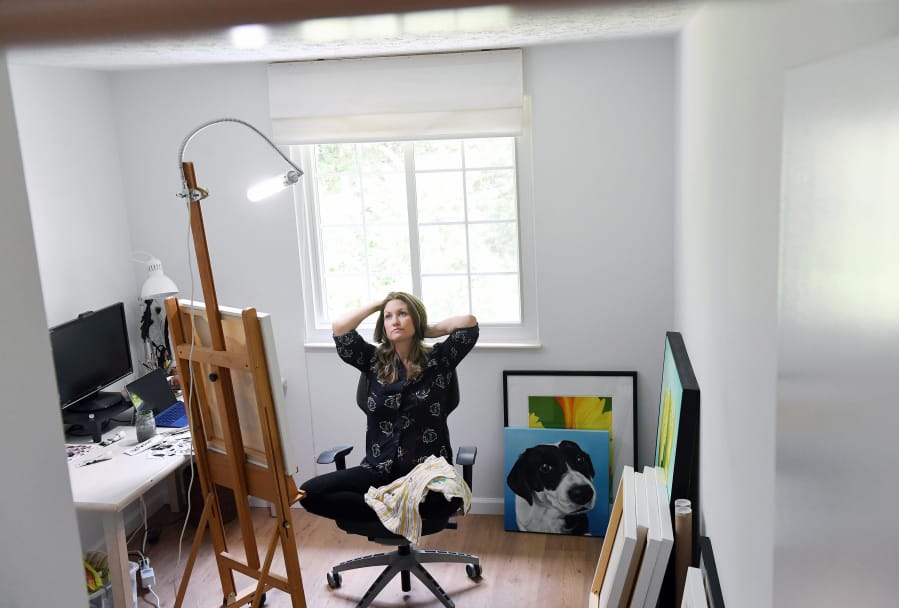RESTON, Va. — Erica Eriksdotter always paints the eyes first.
“The eyes are the most important part,” Eriksdotter said of her hand-painted portraits of dead or dying pets. “The eyes are the windows to the soul, basically. So if you do not get the eyes right, you’re screwed.”
Eriksdotter, 39, spends her days painting pictures of deceased pets — as well as healthy animals — in her home studio in Reston, Va. She’s been doing it since she quit her job as a public relations consultant in 2017 to focus on her business, Studio Eriksdotter. Painting has been a favorite pastime for much longer: ever since she sold her first picture of a red balloon at age 10.
Her pet portraits start at $774 for a 12-by-12-inch canvas and go up from there. Each one takes her about a month to complete.
The price tag may seem hefty, but demand for her portraits is exploding among D.C.-area pet owners: Eriksdotter’s wait list is six months long. And her work is starting to catch on outside Washington. Of the more than 60 pet portraits she has completed, about two dozen have shipped to other states, she said. She also paints bridal bouquets and other flowers, but her focus is pets.
So far, she has painted only dogs and cats, documenting all of her work on Instagram. Eriksdotter is willing to paint pretty much any animal, though. She’s “holding out hope” for a snake sometime soon.
“That would be such an interesting challenge,” she said.
The pet portraits’ popularity may be because of Eriksdotter’s unique process, suggested Antonietta Corvasce, a District of Columbia-based psychotherapist who specializes in grief and loss counseling. Clients who buy paintings of their deceased pets also sign up for several weeks of something akin to therapy.
Eriksdotter asks customers to provide her with photos of the animal, often sending them on nostalgia-filled tours through old memories caught on camera. She also prods them to discuss their pet, initially by asking about basic information — things such as breed and age — that then spur long, emotional emails filled with tales of love and loss, Eriksdotter said.
“It sounds to me like what she’s doing is an effective way of helping people mourn,” Corvasce said. “She’s giving them a safe space to be able to talk about their animal, and by talking about it, that’s a way of mourning, which leads to a place of healing.”
Processing grief
Corvasce added that sometimes, in her own practice, she does something similar to Eriksdotter, asking clients to bring in photographs of deceased loved ones to help them process their feelings. Margaret Capurso, a grief counselor at Washington Home and Community Hospices, said the loss of a pet can have the same impact as the death of a human family member.
“The loss of a pet is no different from a human loss for many,” she said. “What is unique about our pet relationships versus human ones is that our pets provide us with unconditional love … for some folks, they are the only uncomplicated companionship they have.”
Patti Brennan of Indianapolis, who has commissioned four pet portraits from Eriksdotter, knows exactly what Corvasce and Capurso mean. Of the animals featured in her paintings, three are still alive, but one — a Labrador-German shepherd mix named Luke — is gone.
Every time Brennan walks past the paintings, which hang together in her living room, she thinks about Luke and the joy he brought to her life.
“Her work truly captures what I think is the heart and soul of your pet,” Brennan said. “For me, animals are family. Her work embodies that: The animal really leaps off the canvas.”
Losing a pet is a painful experience that Eriksdotter knows firsthand.
She said she is still “in mourning” for Lucas, a Yorkshire terrier who was her constant companion before he died of cancer at age 11, when she was 18. Eriksdotter grew up in Sweden, then moved to the United States for college. She gained citizenship a few years after she married her American husband, Casey Collings, in 2009.
Eriksdotter recalled that Lucas used to wake her and her two sisters every morning by visiting each of their bedrooms. At the end of the day, Eriksdotter fell asleep with Lucas cuddled against her. He came along on every trip to swim practice, insisting on a prime seat in her lap, Eriksdotter said.
The family loved Lucas so much that they bought and fed him cake on his birthdays.
“To this day, we text in a family group message saying ‘Happy Birthday Lucas’ on his birthday,” Eriksdotter said. “I really know what it feels like to lose that beloved pet, that animal who sleeps with you, plays with you, nudges you when you’re super sad.”
In addition to easing grief, Eriksdotter also sees the pet portraits as a way to give back: She donates about 5 percent of her profits every month to animal rescue organizations and domestic violence shelters.
Studio Eriksdotter is a perfect synthesis of Eriksdotter’s three lifelong passions: her love for Lucas, for painting and for her father.
Eriksdotter never took an art class. But she would spend about 20 hours a week behind an easel starting in her mid-20s, a habit she maintained throughout her years working in PR.
She knew it could be difficult to earn a good living as a professional artist. But Eriksdotter’s father, a businessman, had always told her she should pursue a career doing what she loved. Eriksdotter never forgot his words: she still hears his voice in her head today, though he died of pancreatic cancer almost two decades ago.



